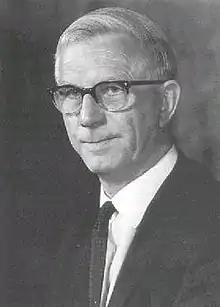Charles Oatley
Sir Charles William Oatley OBE, FRS[1] FREng (14 February 1904 – 11 March 1996) was Professor of Electrical Engineering, University of Cambridge, 1960–1971, and developer of one of the first commercial scanning electron microscopes.[2] He was also a founder member of the Royal Academy of Engineering.
Sir Charles Oatley | |
|---|---|
 Charles William Oatley (1904-1996) | |
| Born | 14 February 1904 |
| Died | 11 March 1996 (aged 92) |
| Nationality | British |
| Alma mater | St. John's College, Cambridge |
| Known for | Scanning electron microscope |
| Awards | Duddell Medal (1969) Royal Medal (1969) Faraday Medal (1970) Mullard Award (1973) Potts Medal (1989) |
| Scientific career | |
| Fields | Physicist and Electronic engineer |
| Institutions | Radio Accessories English Electric Valve Company King's College London ADRDE University of Cambridge |
| Academic advisors | Edward Victor Appleton |
| Doctoral students | Haroon Ahmed Alec Broers Thomas Everhart Colin J. R. Sheppard |
| Influences | John D. Cockcroft |
| Influenced | Constance Tipper |
Biography
He was born in Frome on Valentine's Day, 14 February 1904. A plaque has been placed on the house at the junction of Badcox Parade and Catherine Hill.[3]
He was educated at Bedford Modern School and St. John's College, Cambridge. He lectured at King's College London for 12 years, until the war. He was a director of the English Electric Valve Company from 1966 to 1985.
In 1969 he was elected to the Royal Society.[4]
Oatley also received an Honorary Doctorate from Heriot-Watt University in 1974.[5] In that same year, he was knighted.[6]
He received an Honorary Degree (Doctor of Science) from the University of Bath in 1977.[7] He retired from the English Electric Valve Company in 1985.
He was awarded the Howard N. Potts Medal in 1989. He died on 11 March 1996.
Graduate students
Oatley and the graduate students he supervised made substantial contributions, particularly to the development of the scanning electron microscope (SEM).[8][9][10]
"A project for a PhD student must provide him with good training and, if he is doing experimental work, there is much to be said for choosing a problem which involves the construction or modification of some fairly complicated apparatus. I have always felt that university research in engineering should be adventurous and should not mind tackling speculative projects."[9]:12
His students included:
- Thomas Everhart, former President of Caltech
- Alec Broers, former Vice-Chancellor of the University of Cambridge and former president of the Royal Academy of Engineering.
- Haroon Ahmed, former Master of Corpus Christi College, Cambridge and Professor of Microelectronics
References
- Smith, K. C. A. (1998). "Sir Charles William Oatley, O. B. E. 14 February 1904 – 11 March 1996". Biographical Memoirs of Fellows of the Royal Society. 44: 331–347. doi:10.1098/rsbm.1998.0022.
- Everhart, T. E. (1996). "Persistence pays off: Sir Charles Oatley and the scanning electron microscope" (PDF). Journal of Vacuum Science & Technology B: Microelectronics and Nanometer Structures. 14 (6): 3620. doi:10.1116/1.588737.
- "Plaques". 16 June 2016. Retrieved 2 June 2019.
- "Obituary: Professor Sir Charles Oatley". The Independent. Retrieved 7 April 2016.
- [email protected]. "Heriot-Watt University Edinburgh: Honorary Graduates". www1.hw.ac.uk. Retrieved 7 April 2016.
- "Biography ~ Sir Charles Oatley". www.purbeckradar.org.uk. Retrieved 7 April 2016.
- "Honorary Graduates 1966 to 1988". University of Bath. Retrieved 19 June 2015.
- Hawkes, Peter W. (2004). Advances in imaging and electron physics: Volume 133, Sir Charles Oatley and the Scanning Electron Microscope (1st ed.). Oxford: Elsevier Academic Press. ISBN 978-0123859853.
- Rodenburg, J.M. (1997). Electron microscopy and analysis 1997 : proceedings of the Institute of Physics Electron Microscopy and Analysis Group conference, Cavendish Laboratory, University of Cambridge, 2-5 September 1997. Bristol: Institute of Physics Pub. pp. 11–16. ISBN 978-0750304412. Retrieved 19 June 2015.
- Ratinac, Kyle R. (2008). "Great moment 9: Scanning electron microscopy". In Ratinac, Kyle R. (ed.). 50 great moments : celebrating the golden jubilee of the University of Sydney's Electron Microscope Unit. University of Sydney, N.S.W.: Sydney University Press. pp. 71–81. ISBN 9781920898762. Retrieved 19 June 2015.